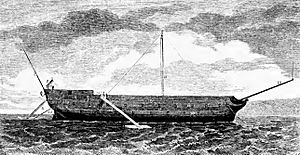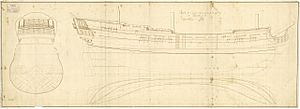HMS Jersey (1736) facts for kids

The Jersey Prison Ship as moored at the Wallabout near Long Island, in the year 1782
|
|
Quick facts for kids History |
|
|---|---|
| Name | HMS Jersey |
| Builder | Plymouth Dockyard |
| Launched | 14 June 1736 |
| Fate | Abandoned and burned to prevent capture, 1783 |
| Notes |
|
| General characteristics | |
| Class and type | 1733 proposals 60-gun fourth rate ship of the line |
| Tons burthen | 1,065 long tons (1,082.1 t) |
| Length | 144 ft (43.9 m) (gundeck) |
| Beam | 41 ft 5 in (12.6 m) |
| Depth of hold | 16 ft 11 in (5.2 m) |
| Propulsion | Sails |
| Sail plan | Full-rigged ship |
| Armament |
|
HMS Jersey was a large 60-gun warship of the Royal Navy in Great Britain. She was built at Plymouth Dockyard and launched on June 14, 1736. Jersey was a "ship of the line," meaning she was a powerful warship designed for battle. She fought in the War of Jenkins' Ear and the Seven Years' War. Later, she was changed into a hospital ship in 1771. In 1780, she became a prison ship for the British during the American Revolutionary War.
Contents
Early Years of HMS Jersey
Jersey was built during a peaceful time for Britain in 1736. Her first major action was in October 1739. This was at the start of the War of Jenkins' Ear. She joined Admiral Edward Vernon's attack on the Spanish port of Cartagena, Colombia.
In June 1745, Jersey was badly damaged in a battle. Her captain wrote that all her sails were shot away. The ropes and masts were also heavily hit. The ship was even taking on water from two shots below the waterline.
Jersey later fought in the Seven Years' War. She also took part in the Battle of Lagos on August 18–19, 1759. This battle was under Admiral Edward Boscawen.
HMS Jersey as a Prison Ship
By March 1771, the old Jersey was changed into a hospital ship. This meant she was used to care for sick or injured sailors. However, in the winter of 1779, she was changed again. This time, she became a prison ship in Wallabout Bay, New York. This area is now part of the Brooklyn Navy Yard.
The British used Jersey to hold Patriot prisoners during the American Revolutionary War. These prisoners were mainly captured soldiers from the Continental Army. Life on board Jersey was extremely difficult for the prisoners.
Life for Prisoners on Board
The conditions on Jersey were very harsh. Men were crowded together below deck. There was little natural light or fresh air. The daily food rations were very small and not enough to live on. The ship was built for about 400 sailors. But up to 1,100 prisoners were kept on board at one time. Historians believe that around 8,000 prisoners were held on Jersey during the war.
As the British faced defeats in the war, the treatment of prisoners got even worse. Guards sometimes took out their anger on the prisoners. It's estimated that about 12,000 American prisoners died on British prison ships during the war. Many died from disease or lack of food.
Every day, as many as eight prisoners from Jersey were quickly buried on shore. This continued until the British surrendered at Yorktown on October 19, 1781. James Forten, who later became an abolitionist, was one of the prisoners held on Jersey. He was captured while serving on a privateer.
Eyewitness Accounts
Christopher Vail, a prisoner on Jersey in 1781, later wrote about his experience. He described how dead men were carried to the forecastle (front part of the ship). Each morning, they were lowered from the ship's side with a rope, "like beasts." He said eight men died each day he was there. Their bodies were taken ashore and buried in shallow holes. It's reported that over 11,700 people were buried this way at that spot.
In 1778, Robert Sheffield escaped from a prison ship. He shared his story in the Connecticut Gazette newspaper. He was one of 350 prisoners kept in a small area below deck.
When the British left New York at the end of 1783, Jersey was left behind. She was then burned to prevent her capture.
The U.S. Department of Defense lists about 4,435 American battle deaths in the Revolutionary War. However, another 20,000 died in captivity, from disease, or other causes. Around 11,000 Americans died on prison ships during the war.
Rediscovery of Jersey
In October 1902, something interesting happened at the Brooklyn Navy Yard. Workers were building the keel for the ship USS Connecticut. They found wood from HMS Jersey while driving piles for a new dock. This was exactly where the burned ship was believed to be after the British abandoned her.
Memorial for Prison Ship Martyrs
The remains of those who died on the prison ships were later reburied. This happened in Fort Greene Park after an earlier burial vault collapsed in 1808. In 1908, a hundred years after the reburial, the Prison Ship Martyrs' Monument was dedicated. This monument honors the thousands of Americans who died on British prison ships during the Revolutionary War.



